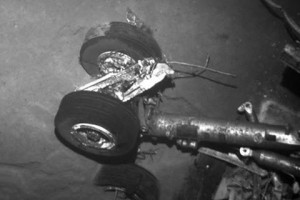AFR447 Update: Why Can’t Airline Pilots Recover From Stalls?
 The French equivalent to the U.S. National Transportation Safety Board — the (Bureau d’Enquêtes et d’Analyses pour la sécurité de l’aviation civile, or BEA) — this morning released an update to its ongoing investigation into the June 1, 2009, crash of Air France Flight 447. The aircraft, an Airbus A330, disappeared over the equatorial Atlantic Ocean en route from Rio de Janeiro to Paris. All 229 passengers and crew aboard were lost. After almost two years of searching, the critical cockpit voice recorder and flight data recorder were recovered from beneath more than 12,000 feet of water earlier this month.
The French equivalent to the U.S. National Transportation Safety Board — the (Bureau d’Enquêtes et d’Analyses pour la sécurité de l’aviation civile, or BEA) — this morning released an update to its ongoing investigation into the June 1, 2009, crash of Air France Flight 447. The aircraft, an Airbus A330, disappeared over the equatorial Atlantic Ocean en route from Rio de Janeiro to Paris. All 229 passengers and crew aboard were lost. After almost two years of searching, the critical cockpit voice recorder and flight data recorder were recovered from beneath more than 12,000 feet of water earlier this month.
Today’s note “describes in a factual manner the chain of events that led to the accident and presents newly established facts.” An English version of the full note, which should be considered nothing more than an interim report (and one designed to stem the tide of media speculation), is available here [PDF].
Boiling it down and omitting details on weather, systems failures and the extent to which the A330′s automation was offline, the BEA is saying the crew stalled the airplane at around FL380 and failed to recover during the three-and-a-half minutes it took to descend to the ocean. (For the math-challenged among us, that translates into roughly a 10,000-fpm descent).
As regular UCAP listeners know, I am rather fascinated by this accident, for any number of reasons. And I’ll/we’ll have additional material and thoughts on it as developments warrant.
But today I’m curious about how and why supposedly well-trained airline crews manage to get their airplanes into stalls and fail to recover them. This question applies to the Colgan Air/Continental Connection Flight 3407, a Bombardier DHC-8, which crashed on approach to Buffalo, NY, February 12, 2009. We talked briefly about this crash in a recent episode and basically asked the same question.
Putting aside the various ways to enter a stall (and the AFR447 and Colgan 3407 accidents are very different in nature except, you know, for the stall thingy…), stall recovery is as elemental to flying an airplane as using a checklist. Stall recovery is something a pre-solo student knows. Stall recovery is something we’re all asked to perform on basic checkrides and the odd BFR. Stall recovery is something every post-solo pilot should be able to do in his or her sleep.
So…how and why can two supposedly well-trained crews flying modern, state-of-the-art aircraft find ways not only to enter a stall but (as the records reflect) make control inputs virtually guaranteed to keep the airplane in the stall, all the way to the ground?
This isn’t rhetorical — I genuinely want to know. Because I simply don’t get it.
Jeb

I’m really puzzled as well.
My only guess in the Airbus is that once Otto checks out, the airplane can get so deep into the stall as to be unrecoverable?
If you’re at the flight levels, in the corner of the envelope between overspeed and stall, and lose airspeed indications, I would think the safest thing to do would be to put the nose down several degrees, retard the throttles and deploy the speed brakes.
As your altitude decreases and the margin between stall and overspeed increases, you start flying an attitude/throttle setting that you know should produce safe, level flight.
I’m imagining we’ll find out soon, but I wonder if 447 departed entirely from controlled flight, and was unrecoverable by normal control inputs? If I remember correctly, investigation of the recovered debris indicated that it impacted the water largely intact, so it’s not like it broke up at altitude.
BEA note says AF447 climbed to 38k from 35k, stalled, then “inputs by the (pilot in control) were mainly nose-up”, descent lasted 3.30 min
So, a post on a car message board of all things has a couple Airbus pilots chiming in.
http://www.mye28.com/viewtopic.php?t=64381&postdays=0&postorder=asc&start=100
So here’s the scenario as it’s presented:
It’s dark, there’s thunderstorms about. Airplane’s being bounced around some. Airplane flies into the top of a thunderstorm, hence the icing.
The pitots ice up, causing a faulty airspeed indication at first, followed very quickly by the various flight management computers throwing up their hands. The airplane is put in ‘alternate law’ where now the protections against overspeed, stall and maximum bank angle are removed.
And oh yeah, now there’s no feedback being fed into the sticks anymore either. It’s unclear to me if the attitude indicators on the PFDs would remain active, or if the whole system simply throws up a red flag due to inconsistent data.
So the pilots have no direct pitch information (Angle of Attack), no airspeed information, and the aircraft is being tossed about. There is no visual reference either, it’s at night in a thunderstorm over the ocean, remember.
The coffin corner for this aircraft at that weight and altitude is apparently 15 knots wide. That’s not a lot of margin between maximum mach and stall.
While the aircraft was stalled, the pilots were getting overspeed warnings at the same time as it started trucking down at high speed. Hence, they reduced throttle at some point.
In alternate law they had no solid aural or visual indications of the aircraft being stalled.
What I’d like to put to an Airbus person is whether the aircraft has enough positive stability to recover from a stall up to only a certain angle of attack. The aircraft was apparently descending at 40 degrees with the nose 15 degrees above the horizon at one point.
With the neutral to negative stability of fly-by wire jetliners, it’s entirely possible, in my mind, that the aircraft could have been in a stable stalled attitude with absolutely no chance of recovery. An aircraft like an A330 is simply never supposed to stall.
The question that the update does not make clear is if there were overspeed warnings. In previous cases (Aeroperu and Birgenair) it was the confusion of simultaneous overspeed and stall warnings that caused the pilots to take the wrong actions.
If like the released update says, there were only stall warnings, it becomes really strange.
The July crash of the C-17 in Alaska was also failure to recover from a stall.
If pitot-statics were frozen or the air data computer failed, it would be difficult to assess which indications were wrong, difficult to see what attitude would be required to correct a stall, and there could be complications with the flight control system.
In the C-17 accident the crew heard the stall warning but ignored it, because they had grown desensitized to the warning in this particular phase of flight by practicing at the edge of the envelope so many times before.
Although the accidents in question are indeed very different, I think there is at least a thread of commonality to them all. The high levels of automation can lead to complacency, and even boredom on the part of the flight crew. A situation that does not lend itself to quick mental engagement when a serious issue arises. Secondarily, I think there can be a real erosion of basic piloting skills as crews move up into larger, faster, more technologically advanced aircraft. Setting pitch and power should be a reasonable option when limited instrumentation is available to the pilot/crew. It would seem that wasn’t attempted.
Having said that, and truly believing that there is potentially a hole in the training of some flight crews – I would be remiss if I didn’t admit that the Air France accident was a significant challenge. The loss of airspeed information would lead to a number of failures, or apparent failures, at exactly the time the flight was heading into truly exciting weather. This was no time to be trying to get your head back in the game, if that was indeed a contributing factor. I feel real empathy for the passengers and crew of that airplane. My interest is intellectual and forward looking. I have no interest in, or intention of, second guessing a crew who were apparently doing everything they could think of to correct the problem – alas, with unsatisfactory results.
The first step to correcting a problem is recognising you have a problem.
In this case, judging by the CVR, the pilots never spoke about the aircraft being stalled.
I think the same goes for Colgen Air, Aeroperu and Birgenair. (Although on the Birginair, a 3rd pilot in the jumpseat started hinting “attitude” but was too much of a sissy to just shout out to the captain he was being an idiot about to kill all of them.)
I think if all of them had known they were in a stall, they probably would have been able to recover.